
white pine trail map pdf
The White Pine Trail Map PDF is a comprehensive guide to the 92-mile Fred Meijer White Pine Trail, offering detailed routes, landmarks, and essential trail information for hikers, bikers, and outdoor enthusiasts. It provides a clear layout of the trail’s paved surfaces, connecting communities, and nearby attractions, ensuring a seamless exploration experience.
1.1 Overview of the White Pine Trail
The White Pine Trail is a 92-mile linear, paved trail stretching from Comstock Park to Cadillac in Michigan. It offers scenic views, recreational opportunities, and connects multiple communities. The trail is suitable for hiking, biking, and horseback riding, with a smooth surface ideal for various activities. Notable points include picnic areas, rest stops, and access to nearby attractions. The trail also features connections to other parks and trails, enhancing its appeal for outdoor enthusiasts. Its length and accessibility make it a popular destination for both locals and visitors, providing a diverse experience amidst Michigan’s natural beauty.
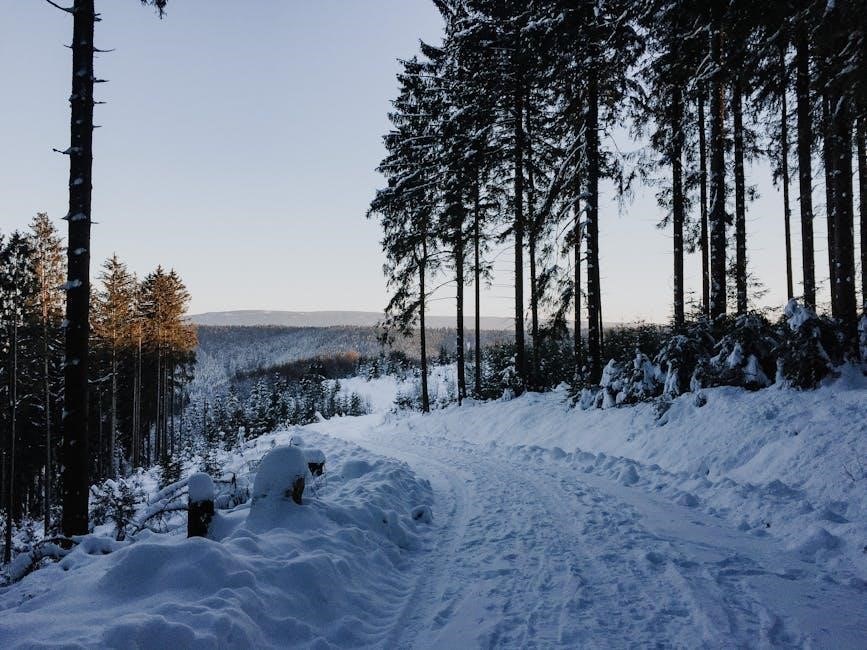
1.2 Importance of the Trail Map
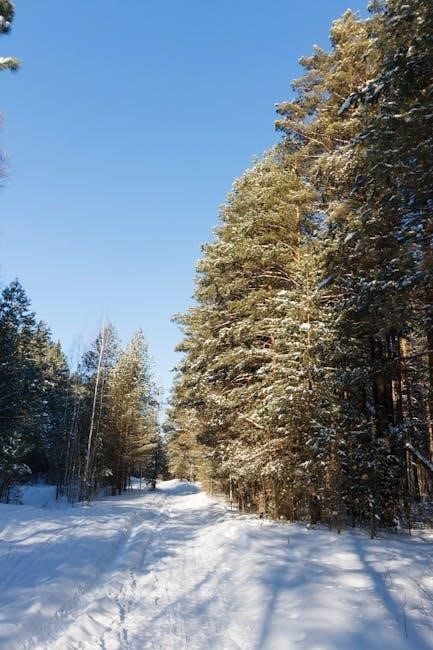
The White Pine Trail Map PDF is essential for navigating the 92-mile trail, providing detailed information on trail segments, mile markers, and key landmarks. It helps users plan their route, identify access points, and locate amenities like parking lots and rest areas. The map also highlights points of interest, ensuring visitors don’t miss scenic spots or historical sites. For safety, it outlines trail rules and etiquette, such as leash requirements for pets and staying on marked paths. Downloadable in PDF format, the map is convenient for offline use, making it a vital resource for hikers, bikers, and outdoor enthusiasts exploring the trail.

History and Development of the White Pine Trail
The White Pine Trail was developed over decades, transforming from a rail line to a 92-mile paved path. Its completion marks a significant achievement in outdoor recreation.
2.1 Origins and Purpose of the Trail
The White Pine Trail originated from the Chicago, Saginaw and Canada Railroad, which operated from 1877 to 1962. After its closure, the corridor was repurposed as a multi-use trail, officially opening in 1995. Its primary purpose is to provide a scenic pathway for hiking, biking, and cross-country skiing, while preserving the region’s natural beauty and historical significance. Stretching 92 miles, it connects multiple communities, fostering economic growth and promoting outdoor recreation. The trail also serves as a vital link for wildlife conservation and environmental education, making it a cherished resource for both locals and visitors.
2.2 Completion of the Paving Project
The White Pine Trail’s paving project was completed in 2015, transforming the once-unpaved path into a smooth, year-round destination. Initially started in the late 1990s, the effort faced delays due to funding challenges. However, through persistent advocacy and grants, the 92-mile trail finally achieved its fully paved status. This upgrade significantly enhanced user experience, making it accessible to cyclists, joggers, and families. The paved surface also boosted local economies by attracting more visitors. Today, the trail stands as a testament to community collaboration and sustainable development, offering a seamless journey through Michigan’s diverse landscapes and connecting rural towns with urban centers.

Trail Details and Specifications
The White Pine Trail stretches 92 miles, connecting multiple counties, with a mix of paved surfaces suitable for biking, walking, and cross-country skiing year-round.
3.1 Length and Surface Type
The White Pine Trail spans approximately 92 miles, making it one of Michigan’s longest trails. The surface is primarily paved, suitable for biking, walking, and cross-country skiing. The trail features smooth asphalt pathways, ideal for cyclists, while also accommodating hikers and snow sports enthusiasts. Some segments include crushed limestone or natural surfaces, offering varied terrain for different preferences. The trail’s length and surface diversity make it accessible for both casual users and endurance athletes. Its well-maintained pathways ensure a safe and enjoyable experience for all visitors, connecting communities and natural landscapes across multiple counties.
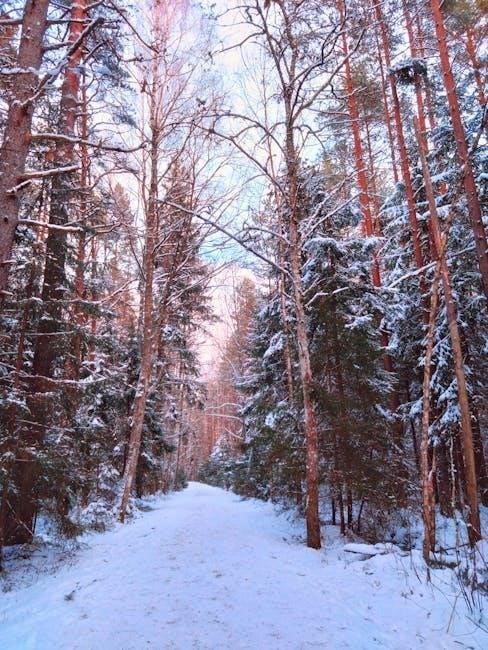
3.2 Trail Segments and Mileage
The White Pine Trail is divided into distinct segments, each offering unique experiences. The total mileage is approximately 92 miles, with sections varying in length and terrain. For example, the northern segment from Cadillac to Gaylord spans about 22 miles, while the southern portion from Grand Rapids to Cedar Springs covers roughly 22 miles as well. The trail is further divided into smaller, manageable sections, making it easy for users to plan their trips. Each segment provides diverse scenery, from dense forests to open fields, ensuring a dynamic adventure. The trail map PDF highlights these divisions, helping users navigate and explore the trail efficiently.

Map Features and Key Landmarks
The White Pine Trail map highlights key landmarks like trailheads, rest areas, and scenic overlooks. It includes symbols for water sources, parking lots, and emergency shelters, ensuring easy navigation. The map also marks notable points such as historic sites, wildlife areas, and connecting trails, providing a comprehensive guide for users to explore the region. Visual elements like color-coded segments and mileage markers enhance readability, making it easier to plan trips and discover hidden gems along the trail.
4.1 Notable Points of Interest
The White Pine Trail map PDF highlights several notable points of interest, including scenic overlooks, historic sites, and wildlife habitats. Key landmarks such as the Pere Marquette River crossing and the Tippy Dam are clearly marked, offering picturesque spots for photography and reflection. The trail also passes through charming towns, where users can access local amenities. Parking areas and restrooms are indicated for convenience, while signs for water sources and emergency shelters ensure preparedness. The map also points out connections to other trails, allowing adventurers to explore beyond the White Pine Trail. These features make the map an invaluable resource for planning an enjoyable and safe journey.
4.2 Trail Markings and Signage
The White Pine Trail map PDF provides detailed information about trail markings and signage, ensuring easy navigation. Mile markers are placed at regular intervals, helping users track their progress. Directional signs at key intersections guide trail users, while informational signs highlight rules, regulations, and historical context. The map indicates areas with interpretive signs, offering insights into the trail’s natural and cultural significance. Symbols and color coding differentiate between trail types, such as paved sections versus natural paths. This clear system ensures users can stay on course and make informed decisions about their route. The signage enhances safety and enriches the overall trail experience for all users.
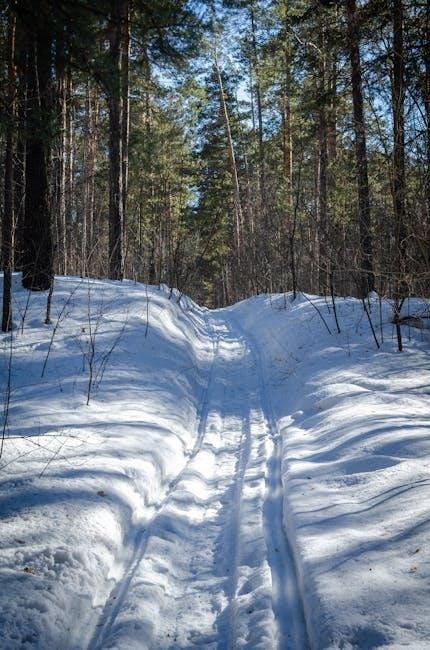
Downloading the White Pine Trail Map PDF
Download the White Pine Trail map PDF from official sources for accurate trail details. The process is straightforward, ensuring easy access on various devices. Stay informed and navigate efficiently with the latest version.
5.1 Official Sources for the Map
The White Pine Trail map PDF is available for download from official sources, including the Michigan Department of Natural Resources (DNR) website and local park authority sites. These platforms ensure the most accurate and up-to-date trail information. Additionally, official trail websites often provide downloadable versions optimized for printing or mobile devices. Visitors can also check local tourism or outdoor recreation websites, which frequently host trail maps for public use. Always verify the source to ensure the map is reliable and current, as unofficial versions may contain outdated or incorrect information.
5.2 Alternative Versions and Formats
Besides the standard PDF, the White Pine Trail map is available in alternative formats to cater to different user preferences. Interactive digital versions can be accessed via mobile apps like Avenza Maps or TrailLink, allowing real-time GPS tracking. For those who prefer visual guides, the map is also available as downloadable PNG or JPEG files. Additionally, some third-party websites offer geospatial data for advanced planning. Printed copies can be obtained from local outfitters or visitor centers. These alternatives ensure that users can access the trail information in a format that best suits their needs, enhancing their overall experience.
Trail Access and Parking
The White Pine Trail offers multiple access points with convenient parking lots along its length, ensuring easy entry for hikers, bikers, and skiers of all levels;
6.1 Main Access Points
The White Pine Trail features several main access points, including Cadillac, Reed City, and Big Rapids, providing convenient entry for users. These points are well-marked and accessible, with nearby parking lots. Cadillac offers ample parking near the trailhead, while Reed City provides easy access with restrooms and picnic areas. Big Rapids boasts a large parking lot and connections to local parks. These access points cater to hikers, bikers, and cross-country skiers, ensuring a smooth start to adventures along the trail. Each location is strategically placed to maximize convenience and accessibility for visitors exploring the White Pine Trail’s scenic beauty.
6.2 Parking Lots and Regulations
Several parking lots are strategically located along the White Pine Trail, offering convenient access for visitors. These lots are typically found near trailheads and popular access points, such as Cadillac, Reed City, and Big Rapids. Parking is generally free, though some areas may require a permit or have time restrictions. Regulations vary by location, but most lots prohibit overnight parking unless explicitly allowed. It’s essential to adhere to posted signs and rules to ensure a smooth experience. The parking areas are well-maintained, providing a safe space to leave vehicles while exploring the trail. Always check local guidelines before parking.
Nearby Attractions and Connections
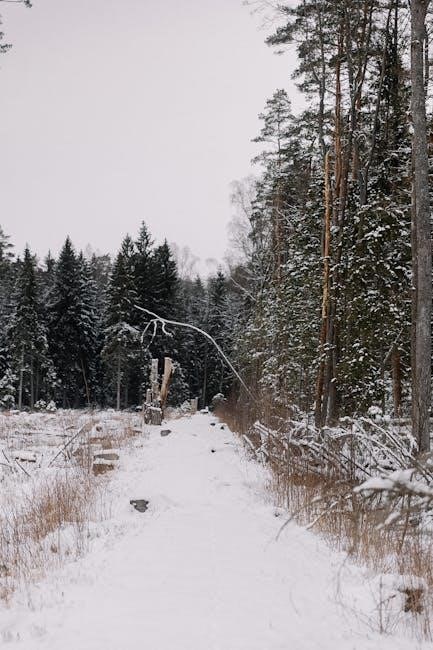
The White Pine Trail connects to numerous attractions, including nearby parks, scenic overlooks, and charming local communities. These connections offer endless opportunities for exploration and enjoyment.
7.1 Connecting Trails and Parks
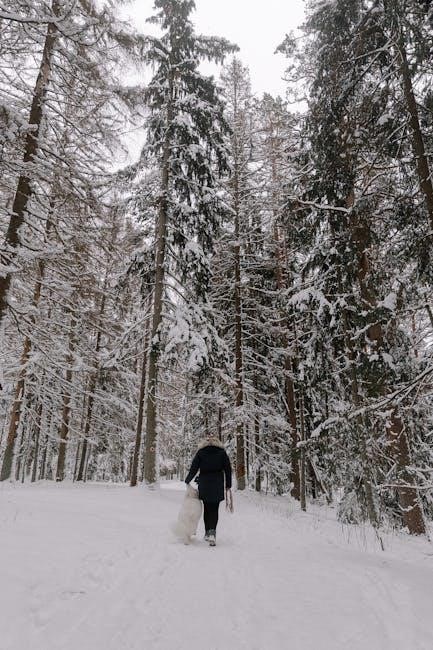
The White Pine Trail seamlessly connects to several regional trails and parks, expanding exploration opportunities. It links to the North Country Trail, Pere Marquette Rail-Trail, and local pathways, creating a vast network for hikers and bikers. Nearby parks like Sleeping Bear Dunes National Lakeshore and Grand Rapids’ Millennium Park offer additional outdoor adventures. The trail also intersects with state game areas and nature preserves, providing access to diverse landscapes and wildlife. These connections make the White Pine Trail a gateway to Michigan’s natural beauty, encouraging users to venture beyond the trail and discover more of the region’s scenic and recreational treasures.
7.2 Local Communities and Amenities
The White Pine Trail passes through charming local communities, offering a blend of small-town hospitality and modern amenities. Towns like Cadillac, Grand Rapids, and Reed City provide convenient access to dining, lodging, and shopping. Visitors can enjoy local eateries, cafes, and craft breweries, while nearby hotels and bed-and-breakfasts cater to trail users. The trail also features parking areas and rest stops, ensuring a seamless experience. Local bike shops and outdoor gear stores are available for rentals and repairs; These communities enrich the trail experience, providing both practical resources and cultural attractions, making the White Pine Trail a hub for both outdoor adventure and local exploration.
Safety Tips and Regulations
Always carry water, wear helmets, and follow speed limits. Stay alert for pedestrians and wildlife. Obey trail rules and be prepared for emergencies with basic supplies.
8.1 Trail Rules and Etiquette
Respect trail rules by staying on designated paths and following directional signs. Motorized vehicles are prohibited except for maintenance. Keep pets leashed and clean up after them. Yield to pedestrians and slower-moving users, announcing your approach when passing. Avoid littering and carry out all trash. Be mindful of noise levels to preserve the natural environment. No camping or open fires are allowed on the trail. Follow posted speed limits, especially near crossings and crowded areas. Report any trail damage or hazards to local authorities promptly. Always carry a map or GPS device and inform someone of your route and expected return time.
8.2 Emergency Services and Precautions
Always carry a fully charged phone and know the nearest emergency contact number: 911 or the local sheriff’s office. Familiarize yourself with trail markers and mileposts to provide precise locations in emergencies. Inform a trusted person of your itinerary, including entry and expected exit times. Stay on designated paths to avoid getting lost and be aware of changing weather conditions. Keep a basic first-aid kit and know how to administer first aid. In case of an injury, remain calm and seek assistance from trail users or authorities. Be prepared for limited cell service in remote areas. Plan ahead and stay vigilant to ensure a safe and enjoyable experience.
The White Pine Trail Map PDF is a comprehensive guide, offering insights into the trail’s history, features, and essential tips for a memorable experience. Explore responsibly and enjoy!
9.1 Final Thoughts on the White Pine Trail
The White Pine Trail offers a unique blend of natural beauty, recreational opportunities, and historical charm, making it a must-visit destination for outdoor enthusiasts. With its well-maintained surfaces and scenic vistas, the trail caters to hikers, bikers, and cross-country skiers alike. The availability of the White Pine Trail Map PDF ensures that visitors can navigate the trail effortlessly, discovering hidden gems and connecting with nearby attractions. Whether you’re seeking adventure or tranquility, the White Pine Trail promises an unforgettable experience. Plan your visit, explore the diverse landscapes, and create lasting memories in this picturesque setting.
9.2 Encouragement to Explore the Trail
Embark on an unforgettable journey along the White Pine Trail, where nature, history, and adventure await. Whether you’re a seasoned outdoor enthusiast or a casual explorer, the trail offers something for everyone. With the White Pine Trail Map PDF as your guide, discover scenic vistas, charming towns, and diverse wildlife. Lace up your hiking boots, dust off your bike, or strap on your skis—every season brings new opportunities to explore. The trail’s well-marked paths and accessible features ensure a seamless experience. Don’t miss the chance to connect with nature, challenge yourself, and create lasting memories. Start planning your adventure today!